With hills, bluffs, and streams, the ‘Hawkeye state’ is an excellent place to practice birding. You’ve got the Dissected Till Plains, the Mississippi and Missouri river, and an excellent number of trails that offer you a chance to see them in the wild or you can simply wait for them to range and come to you! Today we are going to discuss the popular backyard birds of Iowa and give you a little information about some of the more common birds you can see, as well as where they like to hide and what snacks will tempt their tummies the most. After that we’ll throw in some feeder advice and let you know some of the best locations to spend a little free-time if you want to see these birds in their native settings. Let’s talk about Iowa’s beautiful birds!
3 Categories – 430 Birds
With over 430 birds it would be a Herculean effort to document them all (and we’d probably run the risk of making you sleepy, no matter how enthusiastic a birder you might be!). As such, we are going to take a handful of birds and divide them up by’ seasonal spotting windows’ like this:
- Year-round Resident birds
- Birds of Spring, Summer, and Early Fall
- Fall and Winter Birds
By adopting this method we can ensure that you will know when to look for them as well as what to look for and what kind of snacks they favor the most. Let’s start with the year-rounders!
Iowa’s Year-round Resident birds
These birds have made Iowa their permanent home and you can see them at anytime throughout the year. Most, if not all of them, like to range a bit and if you don’t see them in your local park or out in the city then they might already be in your backyard. See if you can spot one or more of the following this year:
- Black-capped Chickadee
- Northern Cardinal
- European Starling
- Downy Woodpecker
- American Goldfinch
Black-capped Chickadee – Poecile atricapillus
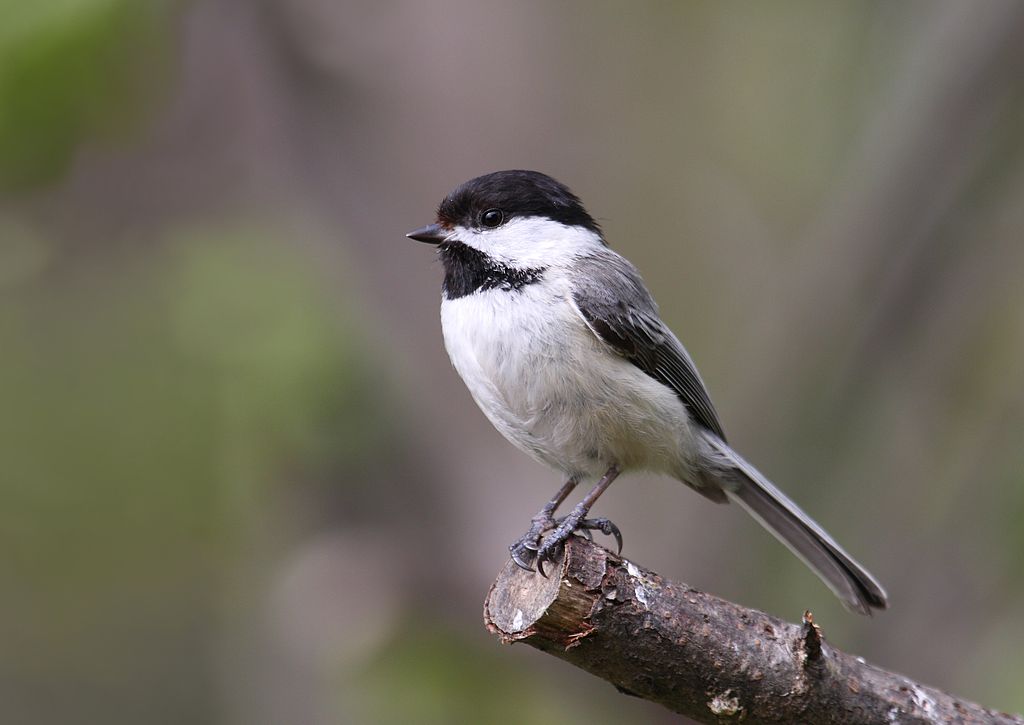
Coloration and Markings: Black-capped Chickadees have velvety-gray backs with short gray or gray and black wings, with a little white edging, and long, thin gray tails. The breast and underbelly of this bird are a snowy white and facially, the center of this bird’s face is white and it has a small, black bib and a large black cap, from the top of the head and down to about mid eye-level. This bird has a small, conical black bill.
Size: These birds measure in at 4.7 – 5.9 inches in length and have wingspans of 6.3 to 8.3 inches.
Habitat: These birds are comfortable anywhere that there are some trees and some dense vegetation to hide out in. You can see them at the forest’s edge or in shrubberies at parks but they are no strangers to fields, marshes, and backyards with stocked-up feeders.
Diet: Suet and peanut butter are 2 favorites of Black-capped Chickadees. Go with the chunky peanut butter for added mileage as they just love that stuff!
Northern Cardinal – Cardinalis cardinalis
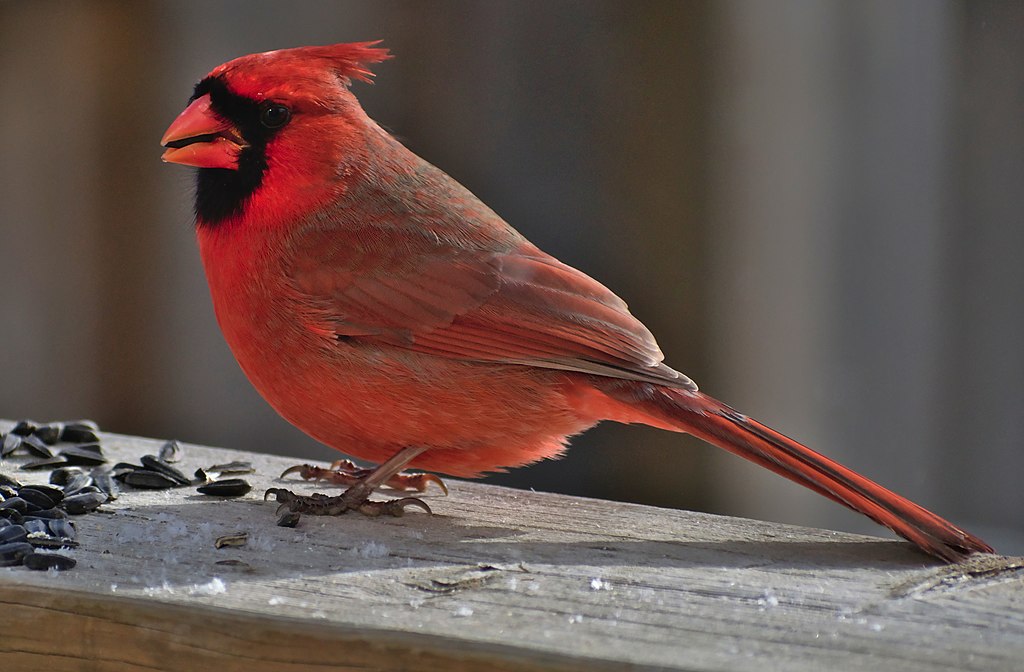
Coloration and Markings: Northern Cardinal males are quite the head-turners, being completely red all over their bodies though you might see a little gray from time to time. They have medium length wings and long tails and facially you will notice the color is slightly richer. The Cardinal has a large, majestic crest and a distinct black mask which goes from the eyes to pull in closely underneath the bill like an ‘evil twin’ goatee. These birds have short, stout, conical orange bills. Females have a different coloration which is also lovely, being a smooth brown with some red highlights and black upon their faces.
Size: These birds are hard to miss, measuring in at 8.3 – 9.1 inches from head to tail and having wingspans with a width of 9.8 to 12.2 inches.
Habitat: While they may be found at the forest’s edge when there is a bit of dense shrub or thicket cover, these birds are fairly urbanized, so you are more likely to see them in your town or city scoping around for good places to forage. Be sure to make one for them!
Diet: Shelled whole or crushed peanuts are a favorite of this bird but they also like suet, cracked corn, and are especially fond of Black Oil Sunflower seeds.
European Starling – Sturnus vulgaris
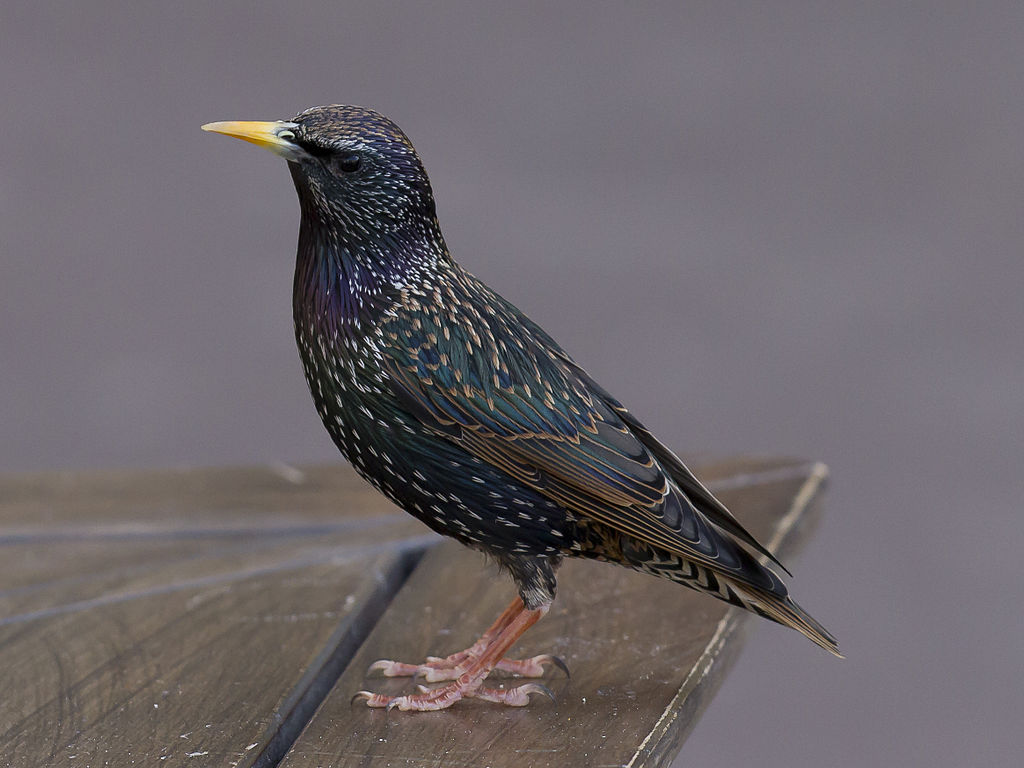
Coloration and Markings: The European Starling looks like any old Blackbird from a distance, though the long, straight yellow bill is a dead giveaway. Up close it’s a different story as this bird wears a lovely and scintillating plumage of purple and green all over it’s body! They have long wings and tails and in the winter they doff their midnight plumage in favor of brown coloration spiced with white spots. It’s something to see, so look out for the Starlings in wintertime especially. It’s a treat!
Size: These birds measure in at 7.9 – 9.1 inches in length with wingspans of 12.2 to 15.8 inches.
Habitat: These are farm and city birds and in some areas are considered a bit of a nuisance, as they tend to run out some local species and often feed in flocks. You can see them on lawns, phone wires, fences, and yes, they will visit the backyard if you leave out a little something for them. They’re pretty birds, just not popular with everyone.
Diet: Suet, Black Oil Sunflower seeds, and fresh or dried berries of just about any kind may lure a European Starling into your backyard for a new and lasting friendship.
Downy Woodpecker – Picoides pubescens
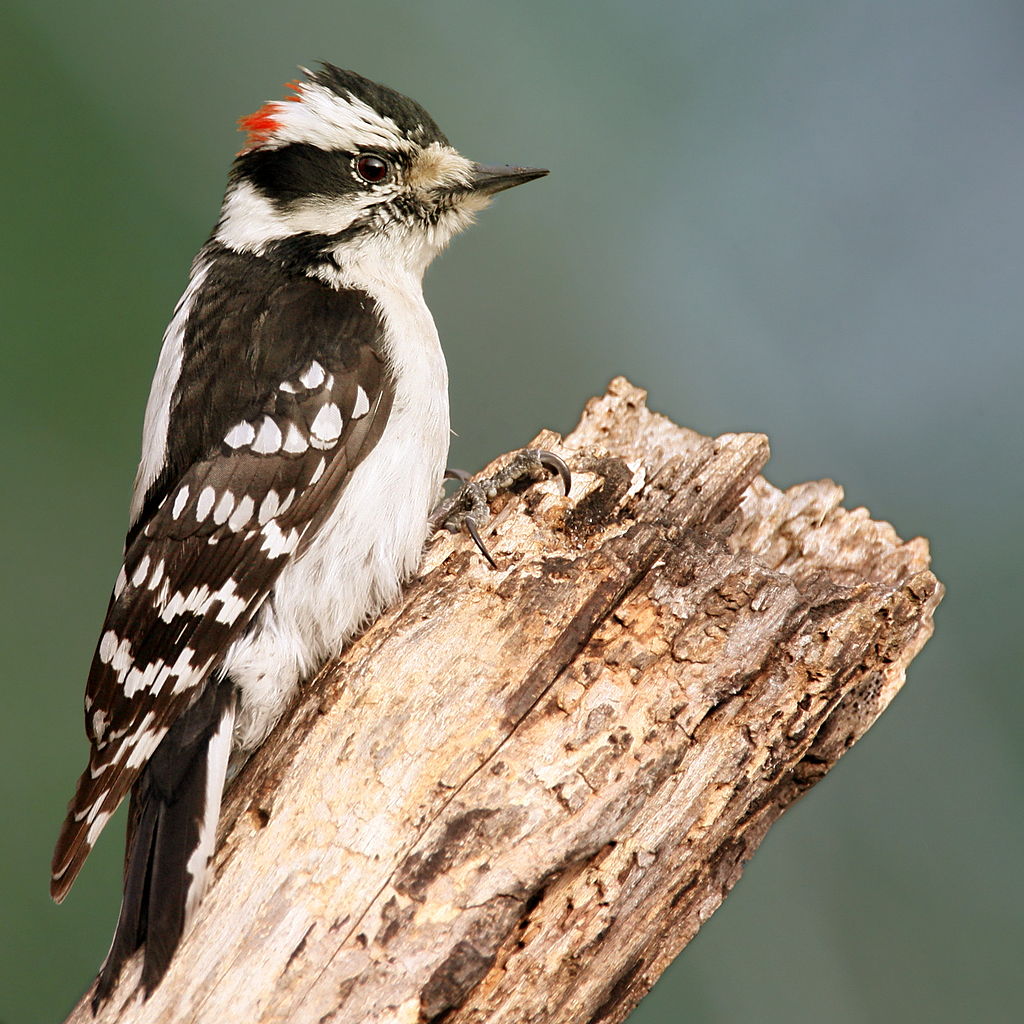
Coloration and Markings: Downy Woodpeckers are quite the lookers, with a wide, white stripe down the back and long, black wings which bear white, zigzagging blocks which make a distinct checkerboard pattern down the wings. The have sturdy, short notched tails which are black on top and white below and their breast and underbelly are paper-white. Facially, these birds have mostly white plumage with a few exceptions. First, there is a black mustache line present, along with a mask which goes to the back of the head, and finally, a thin, black cap. In males, this terminates at a red spot on the back of the head but if it is completely black then you are looking at a female Downy. You may notice a partial, thin white eyering and these birds have thin, straight, and medium-length black bill.
Size: The smallest of the North American Woodpeckers, these cute little guys measure in at 5.5 – 6.7 inches in length and have wingspans of 9.8 to 11.8 inches.
Habitat: These birds love the brush, brambles, and thickets of open deciduous forests. You can spot them in meadows or copses where these is a little dense vegetation present and they are not shy about visiting backyard feeders.
Diet: These birds will eat suet, Black Oil Sunflower seeds, berries, and even wash their snacks down with a sip from the Hummingbird feeder on occasion! Downy Woodpeckers have a bit of a sweet tooth.
American Goldfinch – Spinus tristis

Coloration and Markings: The American Goldfinch is a bright, pretty bird. They have bright yellow backs starkly contrasted by long, black wings, which display 2 white wingbars and and some vertical striping towards the center. This carries down to the long, black tail and you will notice a little white on the underside coming from the rump. The breast and underbelly of this bird are bright yellow and facially you will see the same, with the exception of the bird’s cap. Starting from the top-center of the head and travelling down across the forehead to terminate at the bill, it almost looks like a little toupee. This bird has a medium-length, conical orange bill.
Size: These diminutive rays of sunshine measure in at 4.3 – 5.1 inches from head to tail and have wingspans of 7.5 to 8.7 inches.
Habitat: These birds like open areas with brambles and weeds to hide in. They like to forage in fields and flood-prone areas, but they also range out and visit orchards, parks, and backyards where they’ve been left some welcome-snacks.
Diet: You can sometimes get the American Goldfinches attention with a simple mix of Nyjer thistle and Black Oil Sunflower seeds. If they notice that you’ve got it in your feeder then look out, they may come in drovs!
Iowa’s Birds of Spring, Summer, and Early Fall
When February starts bleeding into March you will see the wildflowers starting to struggle their way up but the earliest sign of spring in Iowa is typically those v-formations of ducks and geese arriving in droves! Next along come the Robins and before you know it the warm season is upon Iowa. These birds listed below may be spotted during spring, summer, or early fall in the Hawkeye state:
- Indigo Bunting
- Barn Swallow
- Eastern Kingbird
- Yellow-billed Cuckoo
- Scarlet Tanager
Indigo Bunting – Passerina cyanea

Coloration and Markings: Indigo Bunting males are a lovely shade of blue all over, with a few small exceptions. You will sometimes see a little black or gray towards the tips of their medium-length wings as well as around the center of their long, rounded tails. This blue is richer on the face and you will notice a small crest on this bird and a little black sometimes is present between the eye and the bill. The bill is silver-gray and straight, though the upper half will display a slight curve to it. Young males will be a mix of brown and blue patches and females will be brown with minor touches of blue, streaked breast, and some white around the throat.
Size: These are small birds, measuring in at 4.7 – 5.1 inches in length with wingspans of 7.5 to 8.7 inches.
Habitat: Indigo Buntings are birds of brush, brambles, thickets, and thorns. If there is a bit of dense shrubbery around then there might just be a Bunting inside.
Diet: Nyjer thistle is good and live mealworms might also get their attention.
Barn Swallow – Hirundo rustica
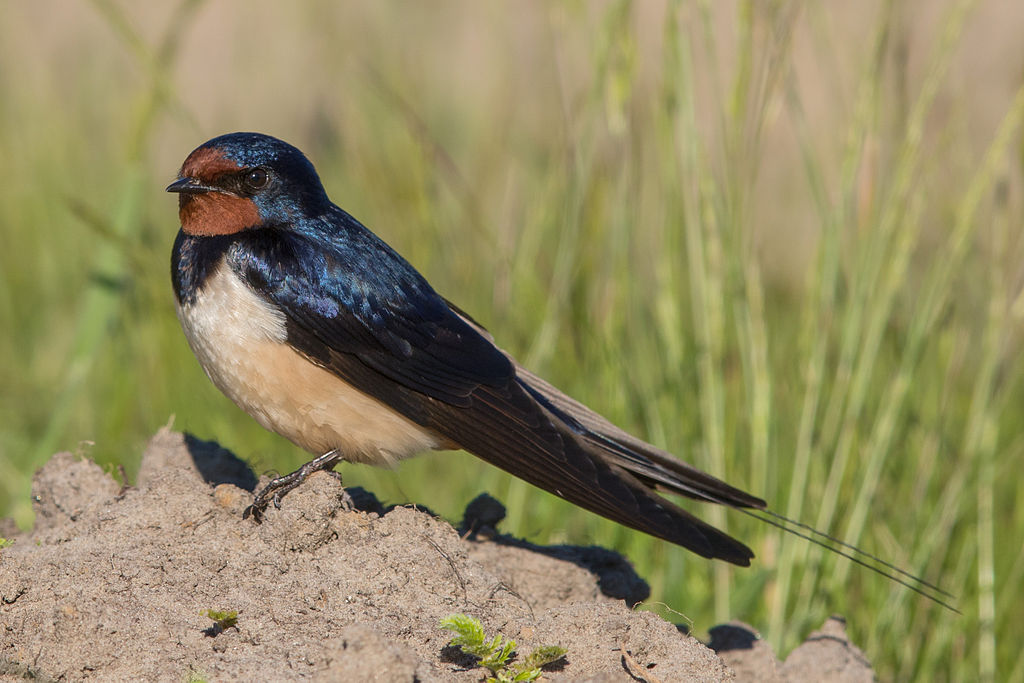
Coloration and Markings: Barn Swallows have the kind of coloration that gets your imagination going. These birds have deep blue backs and wings, with a wee bit of white at the shoulders and some blue going from the back to the front of the breast, pointing inward on each side. This rather looks like a cape and the remaining plumage makes up quite the costume. The tail is long, blue, and forked with some white highlights and some white underneath from the rump. The breast and underbelly will typically be a lovely orange, which reddens a bit between the ‘cape fasteners’ and carries up into the bottom of the face. The orange-red goes from just in front of the back of the head, outlining the cheeks, and triangulating up above the bill, while the cheeks and upper portion of the head are a deep, stunning blue. This bird has a black mask which is diamond-shaped and a thin, straight bill. Females look much the same but have muted colors.
Size: These birds measure in at 5.9 – 7.5 inches in length with wingspans of 11.4 to 12.6 inches in width.
Habitat: These birds love open areas and may often be found at the forest’s edge, in fields, meadows, and copses and they are also fond of water, so look near ponds as well. They like to nest in buildings and bridges around the city, too, so keep an eye out!
Diet: You might have a little luck with some chopped, fresh berries (or whole, small berries such as Blueberries). These birds eat mostly insects but sometimes supplement their diet with berries. You can hedge your bets a little with some live or dried mealworms in the feeder.
Eastern Kingbird – Tyrannus tyrannus
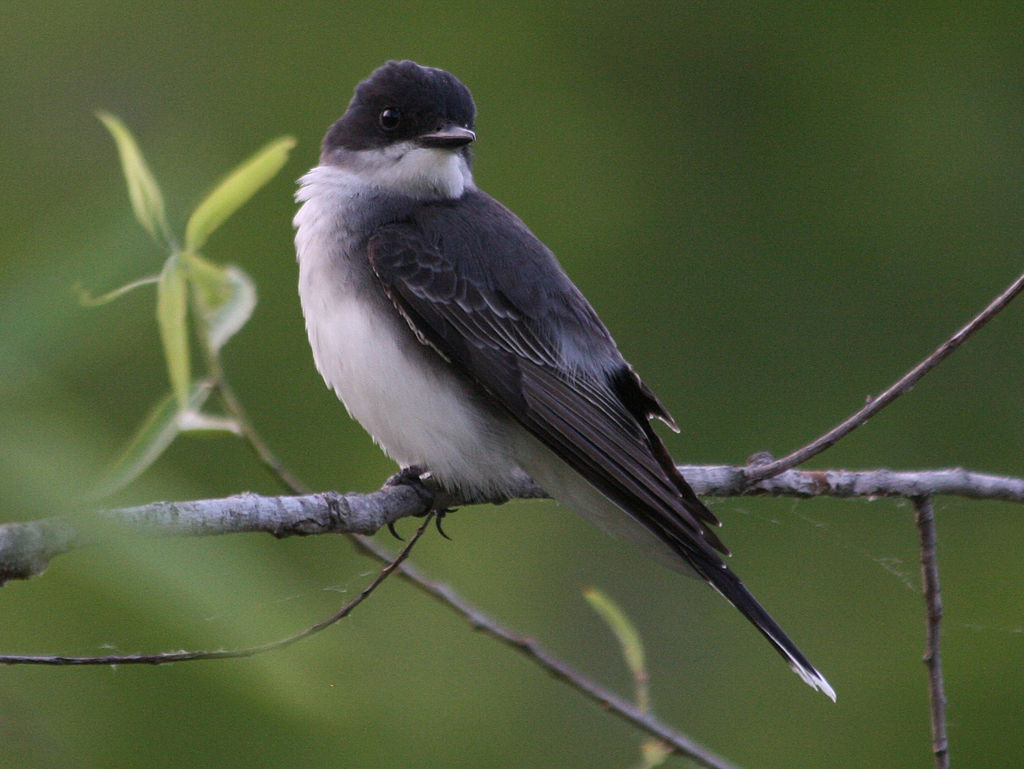
Coloration and Markings: Eastern Kingbirds has velvety dark-gray backs, with long and dark gray-to black wings, edged minutely in white, and long, white-tipped dark tails. The breast and underbelly of this bird are snowy-white and this white carries up into the lower half of the face, spreading 23 of the way towards the back of the head horizontally and vertically framing the cheek and stopping mid-bill level. The top half of the face is black and it looks like the bird is wearing a hood. This bird has a long, straight black bill.
Size: These birds measure in at 7.5 – 9.1 inches in length with wingspans of approximately 13 to 15 inches.
Habitat: These birds love open areas, such as weedy or grassy fields and areas prone to flooding. You can also see them at the edge of the woods, especially if there is a pond nearby.
Diet: These birds like insects and fruit, so try some dried mealworms and chopped apples in your feeder. If you have some fruiting trees or vines this may be more likely to attract them, however, as they can be a little feeder shy.
Yellow-billed Cuckoo – Coccyzus americanus

Coloration and Markings: Yellow-billed Cuckoos have soft, brown backs and medium-length wings which are mostly soft-brown but become a foxy red-brown towards the tips. They have long, beautiful tails which are fox-red in the middle but black on the sides, with distinctive white spots. Their breast and underbelly is paper-white and this carries up into the mostly-white face. A brown mask goes over the eye and curves down to the back of the neck and this bird has a medium length, slightly curved yellow bill.
Size: These are good-sized birds, measuring in at 10.2 – 11.8 inches in length with wingspans of 15 to 16.9 inches.
Habitat: These birds love the treetops in deciduous woods and they favor meadows, clearings, and copses.
Diet: These birds mostly eat live prey, such as caterpillars, frogs, and even small birds on occasion. You might have some luck with some dried or better, live mealworms, and they also sometimes eat fruit. Some chopped apples or whole, small berries might do the trick nicely.
Scarlet Tanager – Piranga olivacea
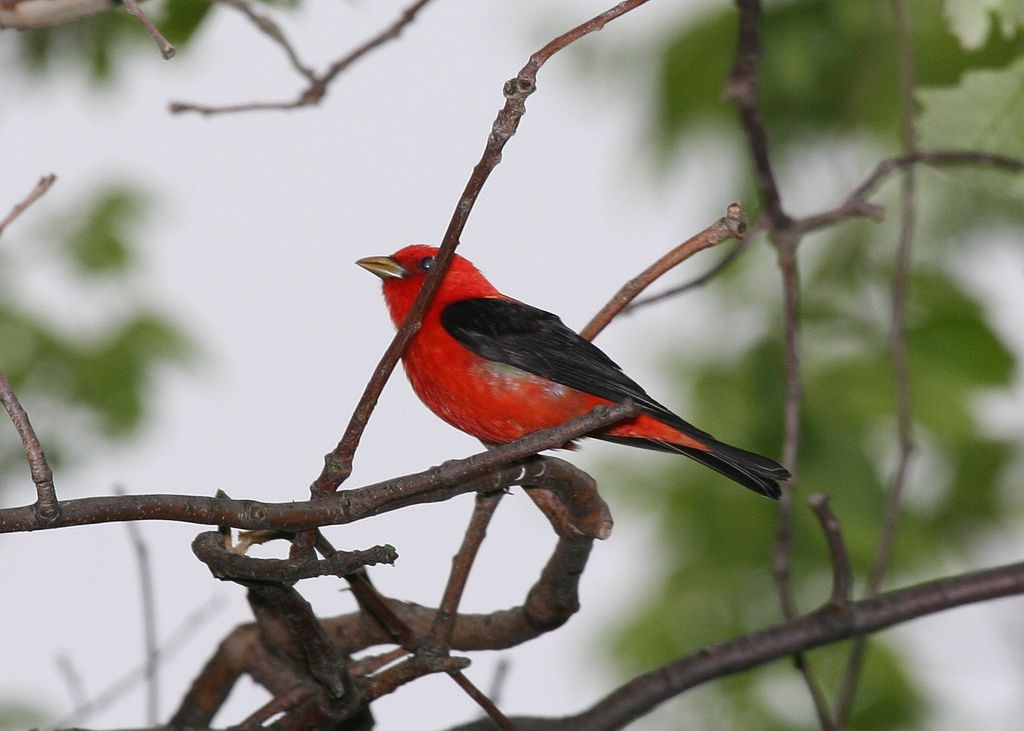
Coloration and Markings: Scarlet Tanagers have stunning coloration. They are a vibrant, rich red all over with the exception of their long, black wings and their medium-length, forked black tails. The wings will sometimes display a yellow wingbar but usually the wing is just black. Females and juveniles, by contrast, are an olive and yellow color, with darker olive coloration on the wings and tail. If you see an olive tanager with completely black wings then you are seeing a male in his new post-breeding plumage. It looks female at first but the black wings are a dead giveaway.
Size: These birds measure in at 6.3 – 6.7 inches in length and have wingspans around 9.8 to 11.4 inches.
Habitat: Tanagers favor deciduous and evergreen-deciduous mixes when it comes to spending time in the forest. In the winter they are a little less picky and range out, often selecting areas with some shrub-cover and that DOES include backyards.
Diet: Scarlet Tanagers eat mostly insects but they do sup on berries from time to time. Try a mix of Mulberries and Blueberries in your feeder and this might get their attentions.
Iowa’s Fall and Winter Birds
Iowa winters have a kick to them, getting as low as 14 degrees Fahrenheit once winter has set her claws into the state. The birds you can see at this time don’t mind in the slightest, having ‘brought their coats’ as you can see reflected in new plumage and open defiance of the weather. See if you can spot some of these winter birds as they forage the ground or even better, your backyard:
- House Finch
- American Crow
- Red-bellied Woodpecker
- Brown creeper
- Cedar waxwing
House Finch – Haemorhous mexicanus
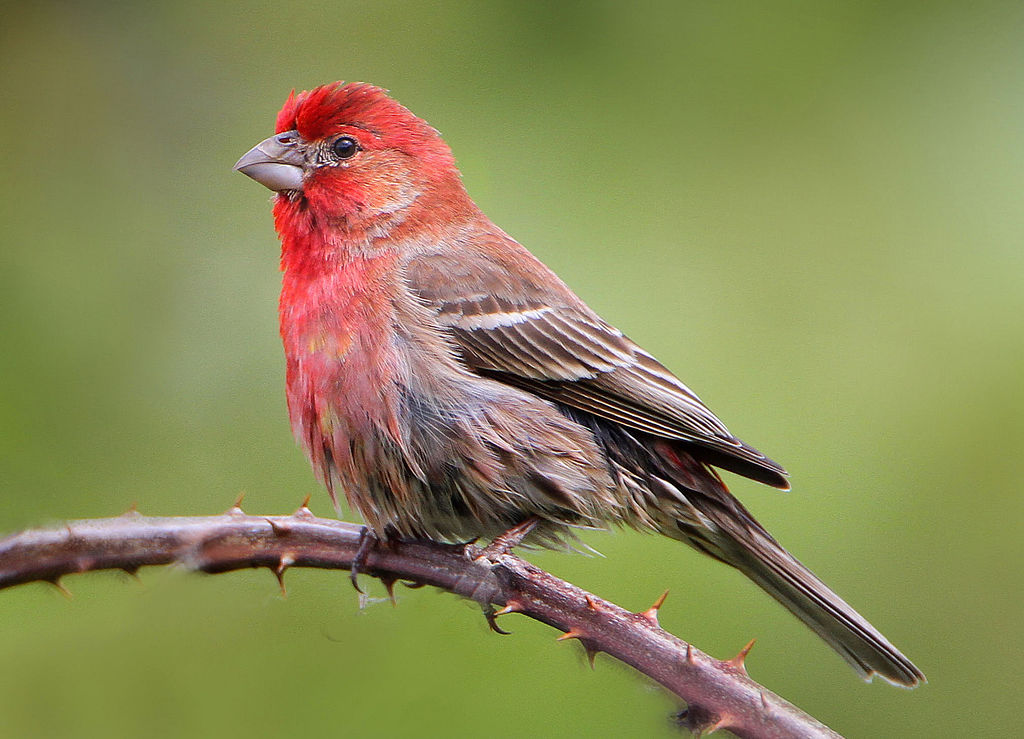
Coloration and Markings: House Finches has brown-to-gray backs with medium-length, darkly streaked wings that have 2 white wingbars on each. They have long, gray to brown tails with white outer edges as well The breast of this bird is white with a heavy saturation of small red spots, which thin out approaching the underbelly, where you will see white with dark streak lines. Facially, this bird is red under the bill and sports a red cap, with a gray eyeline that curves around to frame the cheek and is outlined in thin white, with gray underneath that to the back of the head. Females won’t have any red coloration to them or facial markings, but they will have heavier streaking at the breast. These birds have medium-length, straight, stout silver bills, with the upper bill showing some slight curvature.
Size: The Finches measure in at 5.1 – 5.5 inches from tip to tail and have wingspans of 7.9 to 9.8 inches in width.
Habitat: These birds like open areas of the woods, such as clearings, meadows, or the forest’s edge, but mostly you’ll find them flitting about the city in search for snacks. These are quite the suburban birds.
Diet: House Finches love Black Oil Sunflower seeds and many kinds of fruit. Plums, peaches, cherries, and more. Feel free to get creative and use the Sunflower seeds to lure them in to see what you’ve left them.
American Crow – Corvus brachyrhynchos

Coloration and Markings: Easy to identify, the American Crow is completely black, with long wings and tail, and a long, black bill with a slight curve on the upper portion of the bill.
Size: These are big birds, measuring 15.8 – 20.9 inches from tip to tail and having wingspans of 33.5 to 39.4 inches.
Habitat: These birds love open wooded areas and fields but the city is their favorite place to be. You’ll spot them just about anywhere and they will happily visit your backyard if you’ve left out some yummy snacks.
Diet: Crows love just about everything but peanuts and raisins are a couple of their favorites. Do a search for ‘crow box kit’ if you really want to have some fun. Crows are common, yes, but beautiful and intelligent birds and some of the feeders out there are of the puzzle-variety. This means you can feed the Crows bellies and their minds as you watch them solve the puzzle to get the snacks!
Red-bellied Woodpecker – Melanerpes carolinus

Coloration and Markings: Red-bellied Woodpeckers have stunning zebra-like black and white stripes across their backs, their long wings, and even their medium-length tails. They have a white breast and underbelly, with some faint red splashed around the breast and typically a distinct red mark at the underbelly. Facially, this bird has a white face with some faint red at the throat and cheek and a bold red cap which goes to the back of the head and terminates at the base of the neck. This bird has a long, straight black bill.
Size: These birds measure in at approximately 9.4 inches from tip to tail with wingspans of 13 to 16.5 inches.
Habitat: These Woodpeckers love the woods, especially copses or stands of Oak or Hickory. They often range out into parks and are frequent visitors to backyards, provided that you’ve left out a little something for them.
Diet: These birds mostly eat insects but they do have a sweet tooth. Put out a little Black Oil Sunflower seed for the ‘main course’ and nail and orange to a tree for dessert. Red-bellied Woodpeckers love oranges!
Brown creeper – Certhia americana
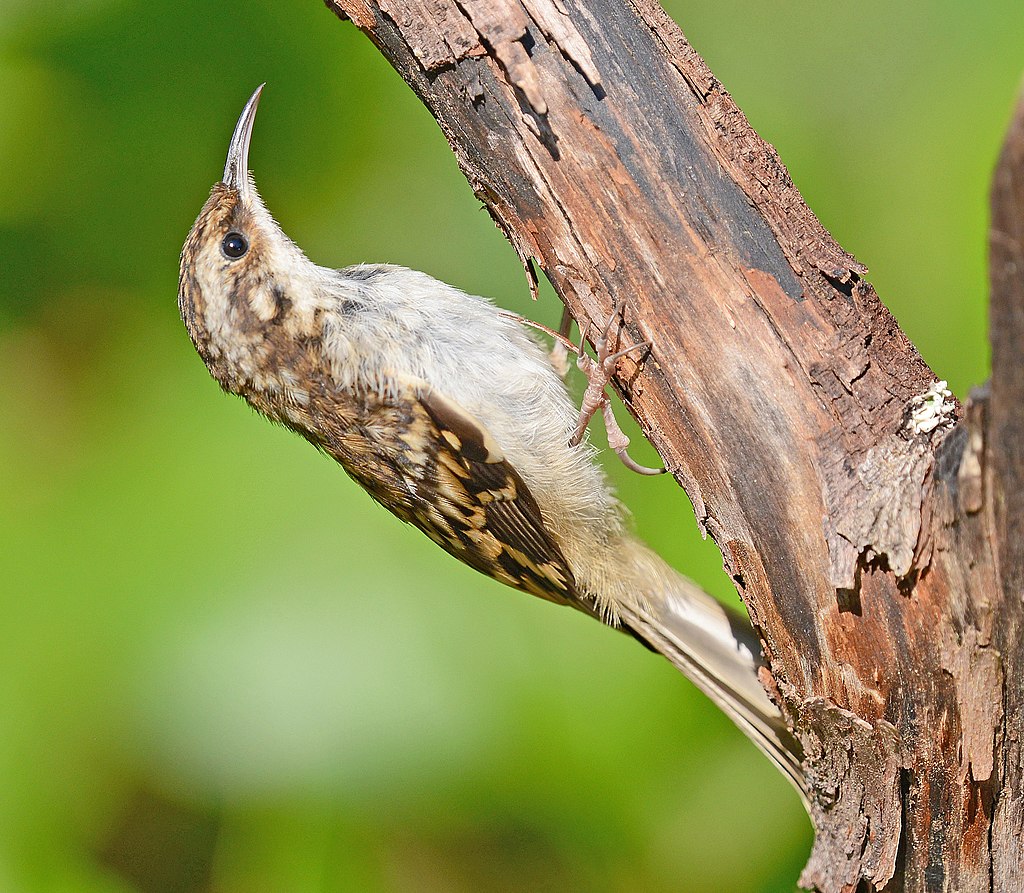
Coloration and Markings: Brown Creepers wear a mantle of buff and brown streaks on their upper bodies. You will see it on their long wings, with some wider black and white stripe patterns and more solid buff towards the wingtips, and their long tails tend to be buff or brown. Their breast and underbelly is snow-white, with the white color going up until just under the bill and expanding vertically until just under and behind the cheek. The rest of the face is buff and brown streaked and this bird has a long, thin bill with a noticeable curve to it. Sometimes there is a little more white to the face and you will always see a buffy-brown streaked eyeline in these cases.
Size: These birds measure in at 4.7 – 5.5 inches in length with wingspans of approximately 6.7 to 7.9 inches.
Habitat: These birds frequent Evergreen forests, especially at higher elevations. In the winter they move down a bit to deciduous woods, parks, and to visit the occasional backyard.
Diet: Chunky peanut butter and Black Oil Sunflower seeds can sometimes tempt the Brown Creeper into visiting your feeder.
Cedar waxwing – Bombycilla cedrorum
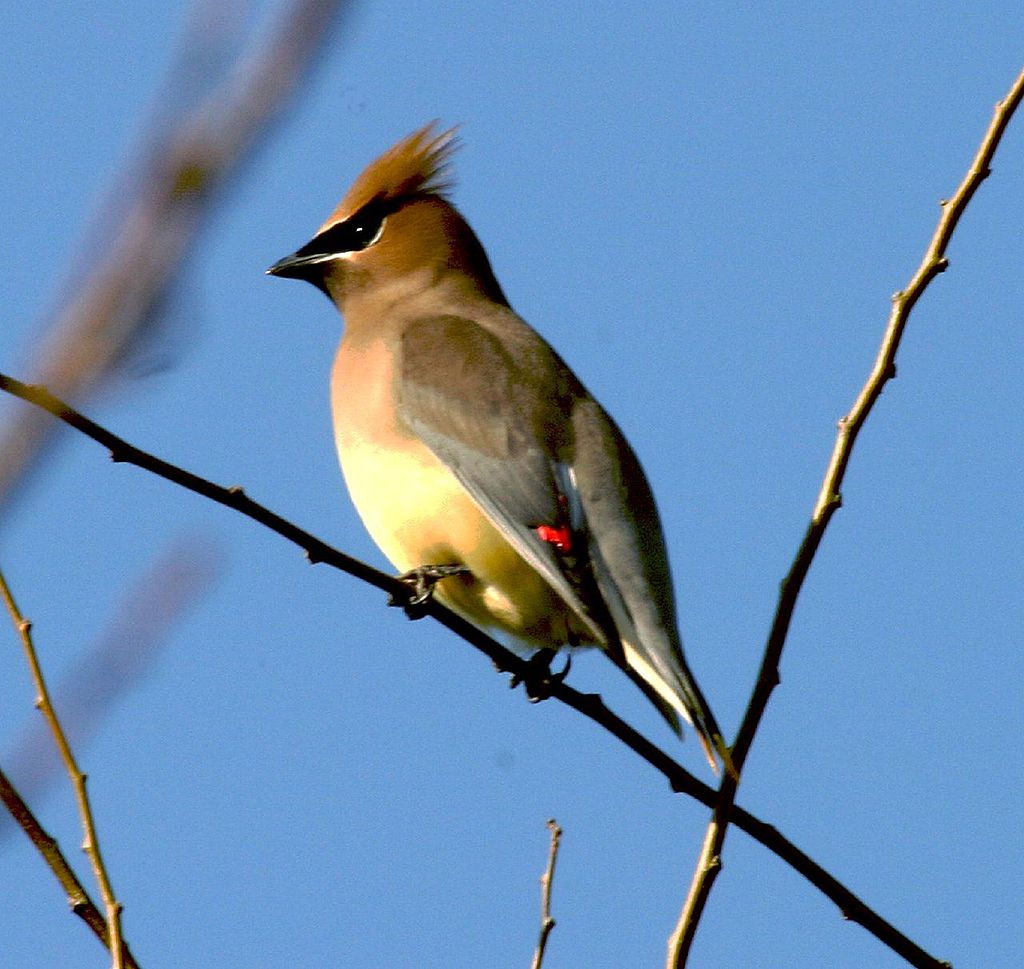
Coloration and Markings: Cedar Waxwings have quite an interesting plumage arrangement. The back and shoulders of the bird are a soft, fluffy brown which quickly turns to a smooth gray on the back and the lower half of the wings. You will notice black at the wingtips and a distinct vertical red ‘wax’ mark consisting of red lines arranged in a descending fashion above the black wingtips. The tail of this bird is short and gray, going to black, and finally yellow at the tips. You’ll see a white rump and the breast and underbelly of this bird will be white with a mix of yellow going up to the breast, where brown coloration comes down like a large beard. Facially, this bird has a lovely crest and it the plumage is mostly soft, light brown, with the brown deepening around the eyes. This bird also has a black mask, which travels past the eyes and curves up to the back of the crest. Some white underscores the black of the mask and this bird has a short, stock straight bill, with a slight curvature present in the upper bill.
Size: These birds measure in at 5.5 – 6.7 inches in length with wingspans of 8.7 to 11.8 inches.
Habitat: Waxwings love the woods but venture out often to visit home gardens, orchards, and backyards, especially if you’ve got a little shrub-cover to help them feel secure.
Diet: Raisins and Black Oil Sunflower seeds are an easy and effective combination for getting the Cedar Waxwing’s attentions.
Supporting cast (Other Backyard Birds of Iowa that might pay you a visit)
We’ve included another small handful of birds that you can see year-round in Iowa. These little guys and gals don’t need to hog the spotlight like our front page contenders, but are still happy to visit and put on a performance for you at any time of the year. See if you notice some of these ‘supporting cast’ birds out on the town or at your backyard feeder,
- White-breasted Nuthatch
- House Sparrow
- Dark-eyed Junco
- Blue Jay
- American Robin
White-breasted Nuthatch – Sitta carolinensis

Coloration and Markings: White-breasted Nuthatches are pretty and easy to identify. They have blue-gray backs with long, blue gray wings and medium-length tails of the same color. Some black highlighting is present on the wings and tail and you may notice a thin, white wingbar on each wing. The breast and underbelly of this bird are snowy white and though it is hard to see, a distinct rust-red spot is present on the underbelly if you look close enough. Facially, this bird has a white face with a thin, black cap and a thin, black line coming from the back of the eye and heading diagonally upward towards the back of the head. These birds have long, straight bills which are often black on the upper half and silver below.
Size: These birds measure in at 5.1 – 5.5 inches in length with wingspans of 7.9 to 10.6 inches.
Habitat: These birds love to frequent mature deciduous and coniferous woods, especially preferring Oak, Maple, and Hickory trees. They do range a lot into parks and especially favor backyards that have a few trees in them.
Diet: White-breasted Nuthatches eat a lot of insects but a suet feeder can easily get and keep their attentions.
House Sparrow – Passer domesticus

Coloration and Markings: Male House Sparrows have a mix of black and foxy brown streaked across their backs, their short wings, and their medium-length, animated tails. Their breast and underbelly is white with a heavy mixture of gray and there is a dense black spotting on the upper breast just under the bird’s small, black bib. This bird has a white throat and cheeks, with an eyeline which starts as black from the bill to the front of the eye and then becomes a thick and rich brown, which carries to the back of the head, and curves down and towards the bill to outline the white cheek. The forehead of this bird is a smooth, velvety gray and these Sparrows have short, stout black bills with a slight curvature on the upper bill. Females tend to be more brown than gray and their breast and underbelly will reflect this as well.
Size: These birds measure in at 5.5 – 6.7 inches in length and have wingspans of 7.5 to 9.8 inches from wingtip to wingtip.
Habitat: The closest these little birds like to get to the woods is a farm. This is because they have spent a long, long time integrating with human society, and thus you are more likely to see them being fed at the park, hopping on sidewalks or scoping out places to snack from phone lines above you.
Diet: You can leave out some cracked corn, wheat, oats, and Black Oil Sunflower seeds for House Swallows and if they notice they will happily gobble it all up!
Dark-eyed Junco – Junco hyemalis

Coloration and Markings: While there are a number of regional differences, a Dark Eyed Junco is typically dark brown or gray, with long, gray wings and a long, gray tail with white undersides. The rump and underbelly of this bird are a frosty white which is heavily flanked by gray as the color moves up the breast. When the Junco is at rest, it rather looks like someone has evenly painted a white layer across the bottom 1/3 of the bird. Facially, this bird is dark brown or gray with the plumage being a little darker just in front of the eye. This bird has a medium-length, conical pink bill.
Size: These birds measure in at 5.5 – 6.3 inches in length with wingspans of 7.1 to 9.8 inches.
Habitat: Juncos love coniferous and mixed coniferous woods when the weather is warm and pleasant but when it gets a little colder they tend to range out into weedy fields, parks, and bird-friendly backyards.
Diet: Cracked corn, White Proso millet, and Black Oil Sunflower seeds (preferably hulled) are all favorites of the Dark-eyed Junco but be sure to use a ground feeder and sprinkle some seeds around it to get their attention.
Blue Jay – Cyanocitta cristata
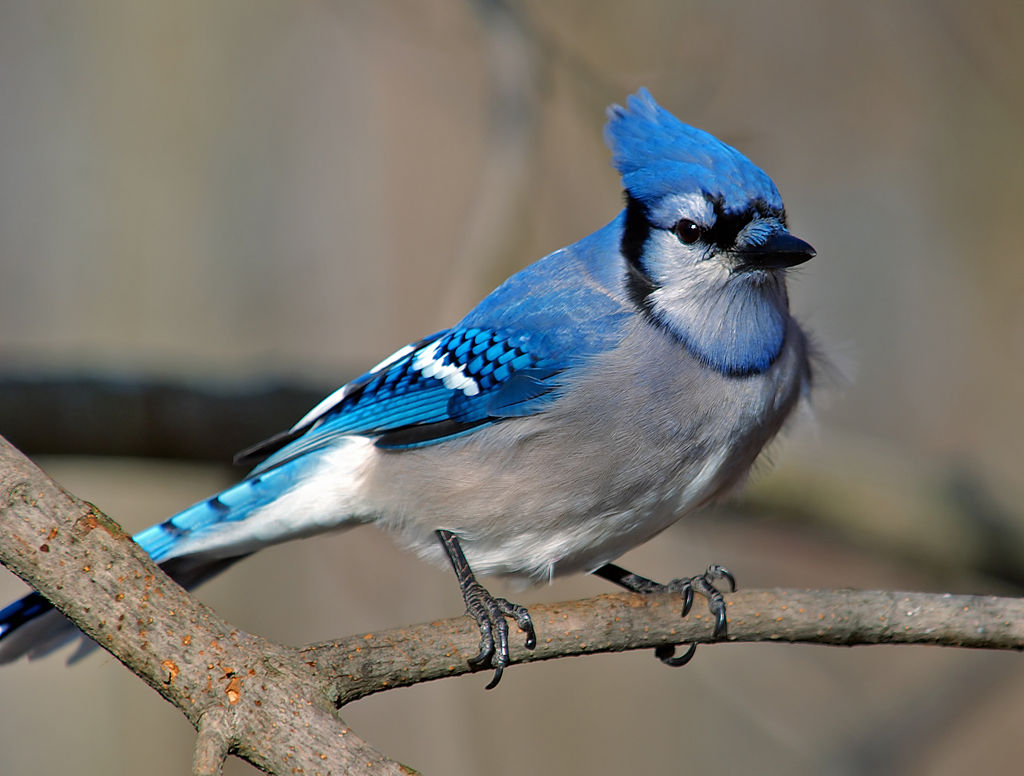
Coloration and Markings: The Blue Jay is handsome and attention getting and you’ll never tire of seeing them. They have a lovely, dark sapphire blue on their backs that deepens on their long wings, where you will see a distinctive, white wingbar with blue-outlined-in-black scaling pattens above and below. Large, white ‘block’ spots are present as well on the wings, outlined in black, and their long tails have a mostly symmetrical pattern of light blue squares outlined in dark blue, with white undersides. The breast and underbelly of this bird are white and this carries up into the face, interrupted briefly by a black line that travels from the back of this bird’s glorious blue crest to circle the throat to the other side. While the large crest is a soft blue, the rest of the face is white except for a zigzagging black mask and a long, straight, and robust black bill.
Size: These are good sized birds, measuring in at 9.8 – 11.8 inches in length with wingspans approaching 13.4 to 16.9 inches of width.
Habitat: Blue Jays love the edge of the woods and especially like to hang around Oak trees, where they can locate, smash, and gobble up yummy acorns. They are not shy about visiting parks or the city, however, and will definitely visit your backyard if you can get their attention with some yummy snacks and some patience.
Diet: Suet, cracked corn, and Black Oil Sunflower seeds are all favorites of this bird. Shelled peanuts are welcome as well and it’s a pleasure watching them shell the nuts to get the yummy snack inside.
American Robin – Turdus migratorius
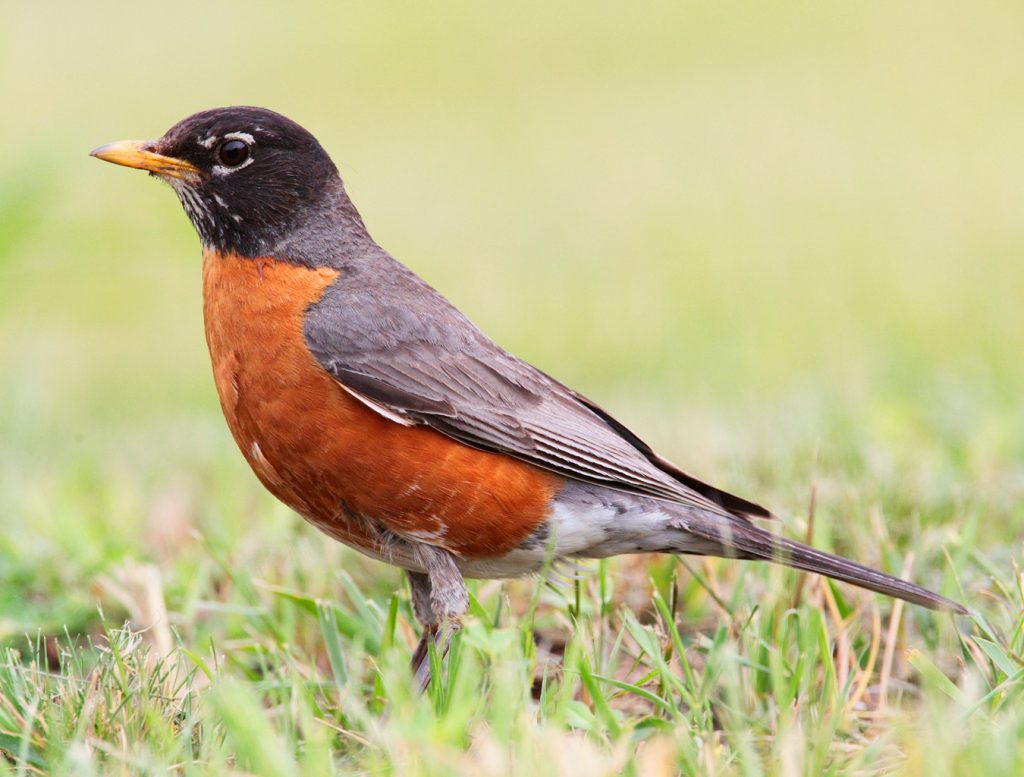
Coloration and Markings: American Robins are lovely and frequent visitors to feeders. They have grayish-brown back, long wings, and darker gray or brown tails which are long, thin, and white on the undersides. They have a white rump but their underbelly and breast will be an orange to orange-red color and facially, their color turns to black. You may notice a broken white eyeline and these birds have medium length, slightly curved yellow bills with a small tuft of white often seen just under the bill. Females have muted colors which are still recognizable but tend to run together, unlike the definite contrasting plumage of the male.
Size: These birds measure in at 7.9 – 11 inches from tip to tail and have wingspans of 12.2 to 15.8 inches.
Habitat: These birds like the woods but it is just as common to see them on fences in the city, in weedy fields, golf courses, or even simply hopping around in the snow as they forage. They will happily visit a well-stocked feeder, especially so in the winter months.
Diet: You can make American Robins quite happy with suet, raisins, and crushed peanuts. Some have reported that they can eventually convince a Robin to eat from their hands but you will want to Google the process and practice a lot of patience if you wish to make this close of a friendship!
Iowa Bird Buffet
When setting up the feeder a little knowledge on the types of birds that you wish to attract is important. To this effect, we have some excellent advice to share from the Iowa University State Extension for creating that perfect-feeder environment to coax those birds directly to your backyard. We’ll throw in a tip of two as well and if you want to see the full article on the subject then be sure to use one of our reference links below. Try adding some of these items to your backyard setup:
- Black Oil Sunflower (50 percent)
- White Proso millet (35 percent)
- Cracked corn (15%)
- A birdbath (especially one that can be warmed in winter)
- Grape jelly
- Suet
Iowa Birding Hot spots
Sometimes you just need to get out of the house and go on a ‘proper’ birding expedition. Sure, it’s nice when they simply come to you, but seeing them in their natural surroundings is just such an addictive thrill. To that effect, if you visit one of the locations below then you will surely get a glimpse of the celebrities of the skies and maybe even snap a few pictures like a proper Chirparazzo. We’ve selected locations across the compass points but if nothing seems close, just click the link which we have provided and you can easily find something that is just around the corner. Visit one of these spots if you get a chance:
- Northern hotspot – Hynes Spur Trail
- Eastern hotspot – Clinton Discovery Trail
- Southern hotspot – Cinder Path
- Western hotspot – Sioux City Riverfront Trail
- Central hotspot – Chichaqua Valley Trail
Detailed descriptions of each location as well as information regarding visiting and what birds you can see at these locations may be found at: https://www.traillink.com/stateactivity/ia-birding-trails/
In Conclusion
We hope that you’ve enjoyed this little exploration of the birding opportunities of Iowa. As you can see from the trail map in our references, it’s hard to throw a stone in Iowa without hitting a lovely trail to explore and visit some of the fine feathered locals. We hope that you’ll take advantage of this when you have a little free time and make some new Avian friends. Until next time, keep your eyes peeled and your feeders full, folks! We wish you your birding best!
